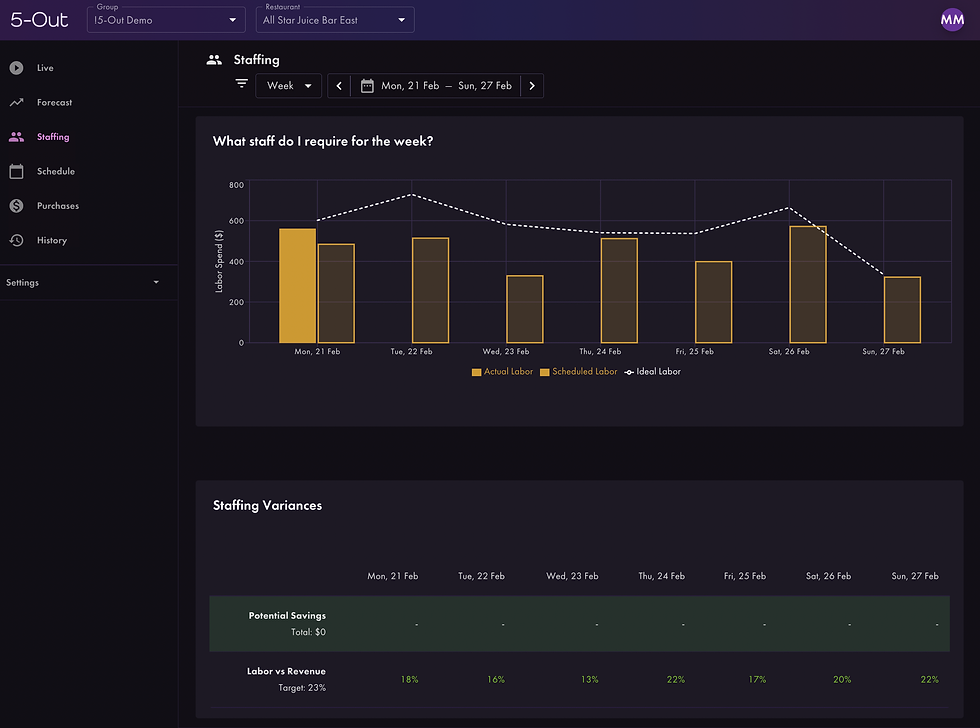How to Optimize Restaurant Margins Amidst Inflation in 2023
- Erin Watkins

- Jul 11, 2023
- 7 min read
Discover strategies for managing restaurant costs in the restaurant industry in 2023 to better increase restaurant margins. Learn how modernizing inventory, controlling usage and waste, and data-driven scheduling can optimize your restaurant's operating costs and drive profitability.
Revenue Optimization

The restaurant industry, especially full-service restaurants, has always faced its fair share of challenges. However, 2023 has introduced an exceptional set of hurdles. With food prices witnessing a significant hike of 6.7%, surpassing the overall inflation rate of 4%, restaurateurs are now confronted with unexpected inflationary strains. When you consider that the average profit margin for a restaurant lies between 3-5%, and juxtapose this with the escalating minimum wages in 23 states and the District of Columbia, it becomes clear that the industry's margins are increasingly narrow.
Such a landscape demands a thorough strategy—a guide to improve your restaurant profit margin, if you will. This strategy must amalgamate inventive tactics, technology tools, and even loyalty programs to guarantee enduring profitability. The essence of this approach is in adeptly managing a restaurant's operating expenses, an extensive category encompassing prime costs like food and labor, as well as rent, utilities, marketing, and beyond.
Amid these intensifying challenges, we explore how ambitious leaders are fine-tuning their restaurant operating costs. Our focus narrows down to three primary domains: updating inventory to oversee food costs, enacting strategies to keep an eye on and minimize usage and waste, and leveraging data to craft efficient schedules. Moreover, the implementation of loyalty programs can also optimize table turnover, ensuring guests keep coming back. Collectively, these strategies are designed to arm restaurant managers with the prowess needed to confront spiraling variable expenses directly, ensuring their establishments remain profitable and robust even in these testing economic times.

The Impact of Rising Food Costs on Restaurants
Unavoidably, food price inflation casts a profound impact on the restaurant industry. With costs escalating by a staggering 6.7% in 2023, the financial strain seeps into the very foundation of running a restaurant: purchasing ingredients. Higher costs for raw materials translate directly into increased operational expenses, squeezing gross profit margins in the restaurant industry unless mitigated by price adjustments in the menu, improvements in efficiency, or a combination of both.
However, adjusting menu prices can be a double-edged sword. While it might offset the increased restaurant expenses, it could also discourage price-sensitive customers, potentially leading to a drop in total sales volume. Similarly, enhancing operational efficiency, while it holds the promise of reduced costs, is not a task that can be achieved overnight. It requires strategic planning and thoughtful implementation, often involving changes in established processes and staff retraining.
This is where the importance of effective Prime Cost management comes into play. In the restaurant business, Prime Cost, an important part of restaurant operating expenses refers to the sum of cost of goods sold (food and beverages) and labor - essentially, the primary areas of expense. A surge in food prices dramatically influences this crucial metric. Thus, achieving a balanced Prime Cost is critical to maintaining profitability.
Effectively managing Prime Cost necessitates a keen understanding of cost behavior and precise monitoring of restaurant operations. In this era of rising food prices, optimizing Prime Cost management could mean the difference between simply staying afloat and truly thriving in the industry. In the following sections, we'll delve into strategies such as modernizing inventory, monitoring usage and waste, and employing data-driven scheduling to help restaurant owners achieve this balance and steer restaurants toward success.

Modernizing Inventory for Efficient Food Cost Management
A well-orchestrated inventory management system is a lifeline in the bustling, unpredictable world of restaurants, especially when food costs are on the rise. It's the linchpin that holds together all cost-related operations, directly impacting a restaurant's bottom line. Efficient inventory management ensures that ingredients are purchased and used optimally, reducing wastage and curtailing unnecessary spending.
However, in the context of escalating food prices, traditional inventory management methods may fall short. That's where the modernization of inventory systems steps in, harnessing technology and analytics to transform the approach toward food cost management.
1. Implementing Inventory Management Software:
Paper-based or simple spreadsheet tracking systems are prone to human error and can often lag behind real-time changes. Modern inventory management software can provide real-time tracking, automated reordering, and waste tracking. These tools not only reduce errors but also save time and total labor costs, making them a valuable investment for any restaurant.
2. Leveraging Data Analytics and AI-Powered Sales Forecasting:
Modern inventory systems should incorporate data analytics to help restaurants predict demand with high precision, reducing the chances of over-purchasing and waste. For example, the use of AI-driven sales forecasting software, like 5-Out, allows restaurants to anticipate future demand patterns based on historical sales data, weather, local events, and more. As a restaurant management system, it doesn't just predict future demand but also provides suggestions about inventory purchasing optimization. By making data-backed decisions, restaurants can better manage their inventory, optimize food cost percentage, and enhance profitability.
Request a demo today to discover how AI-driven sales forecasting can better optimize your inventory and maximize profit margins!

3. Adopting a FIFO (First In, First Out) Approach:
While not a new concept, adopting a strict FIFO approach has become more critical with rising food costs. A modern inventory system can facilitate this process, ensuring older stock is used before newer stock, thus minimizing spoilage and waste.
4. Regular Audits:
Even with the most advanced system in place, regular inventory audits are essential to ensure its effectiveness. These audits can identify discrepancies between the system records and physical stock, helping prevent issues like theft or misuse of ingredients.
By modernizing inventory systems, restaurants can stay one step ahead in the battle against rising food prices. Not only does this approach reduce costs and waste, but it also ensures the freshness of ingredients and, ultimately, the quality of food served to customers.

Monitoring and Controlling Food Usage and Waste
In the complex dance of running a successful restaurant, unchecked usage, and waste can quickly become major stumbling blocks. With rising food prices, these issues become magnified, causing a significant dent in profitability. Unmonitored usage often results in over-portioning, where more food is served than necessary, increasing both costs and waste. Similarly, without effective waste management strategies, surplus food ends up discarded, representing a loss in potential revenue.
However, with well-considered strategies, these challenges can be turned around, optimizing costs and enhancing the sustainability of the restaurant.
1. Portion Control:
An effective way to monitor usage is through portion control. Implementing standardized recipes with exact measurements can ensure consistent quality, prevent over-portioning, and help in maintaining cost efficiency.
2. Training Staff:
Staff plays a crucial role in controlling usage and waste. Ensure that all staff members, from kitchen to service, are trained in waste reduction practices. This includes proper storage, rotation, and portioning of ingredients, and educating about the financial and environmental impacts of waste.
3. Waste Tracking and Analysis:
Utilizing a waste tracking system can provide valuable insights into when and why waste is occurring. It can help identify patterns and pinpoint problematic areas in the food preparation and service process. Once these are identified, appropriate changes can be made to address these issues.
4. Incorporating a Lean Management Approach:
Inspired by the manufacturing industry, a lean management approach aims at reducing waste in all forms while maintaining product quality. This might involve streamlining processes, optimizing inventory based on demand, and continuously improving operational efficiency.
5. Menu Planning:
Thoughtful menu item planning can also reduce waste. This could involve using the same ingredient across multiple dishes or creating specials to use up excess inventory.
Monitoring usage and controlling waste is not just about reducing fixed costs; it's about building a more sustainable and responsible restaurant. By employing these strategies, restaurants can significantly reduce their environmental footprint while improving their bottom line.

Data-Driven Scheduling for Minimized Labor Costs
Beyond food costs, labor is another significant expense in the restaurant industry, especially with minimum wages on the rise. Efficient scheduling plays a crucial role in managing these restaurant costs. Inefficient scheduling can lead to overstaffing during slow periods and understaffing during peak times. The former inflates labor costs unnecessarily, while the latter can compromise service quality, impacting customer satisfaction and potential sales.
Enter the realm of data-driven scheduling, a modern solution that leverages historical data and predictive analytics to optimize staff scheduling.
1. Historical Data Analysis:
By analyzing past sales and traffic data, managers can identify patterns and trends that can inform staffing needs. For instance, if data reveals that Tuesday afternoons are usually slow, fewer staff members can be scheduled during this time. Conversely, if Friday nights are consistently busy, ensuring ample staff during this period can enhance service quality and potentially increase sales.
2. Real-Time Data Utilization:
Using real-time data, managers can make in-the-moment adjustments to the schedule. If a sudden rush or an unexpected lull occurs, staff numbers can be adjusted accordingly to maintain efficiency and control costs.
3. Predictive Analytics and AI-Powered Forecasting:
Advanced scheduling tools today have evolved to leverage predictive analytics to anticipate future staffing requirements. They analyze a variety of factors including historical data, traffic, local events, and weather conditions to offer accurate staffing predictions.
In this respect, the introduction of AI-driven sales forecasting software like 5-Out can revolutionize how restaurants plan their schedules. With the ability to predict future sales with up to 98% confidence, it allows managers to align their staffing levels with anticipated demand accurately. It doesn't just provide a forecast; it also offers actionable recommendations for labor scheduling. This high degree of accuracy and practical guidance helps restaurants optimize their labor cost percentage, reduce overstaffing or understaffing issues, and ensure smooth, efficient operations.
Book a demo now to reduce labor costs by accurate sales forecasts! Better decisions and save money!

4. Employee Availability and Preferences:
While not strictly a cost matter, considering employee availability and preferences when scheduling can improve staff morale and reduce turnover, which is a significant hidden cost in the restaurant industry. Data-driven scheduling tools often include features to track and consider these factors.
With data-driven scheduling, restaurant operators can significantly improve their labor efficiency, aligning staff schedules with customer demand patterns. This approach enables cost reduction, better service, and improved overall operational efficiency. In a climate of rising food and labor costs, it's a vital tool in the quest for sustainable profitability.
In the current climate of rising food prices and minimum wages, restaurants face increasing pressure on their profitability. However, with modern strategies and technological tools, it's possible to turn the tide. By modernizing inventory systems, monitoring usage and waste, and employing data-driven scheduling, restaurants can optimize their restaurant costs and enhance their operational efficiency.
One such tool that stands out in this endeavor is 5-Out, an AI-driven sales forecasting software designed specifically for the restaurant industry. With its capability to predict future sales with up to 98% confidence and offer recommendations for both inventory purchasing and labor scheduling, 5-Out can be a game-changer for your restaurant.
Try 5-Out today and see how it can drive your restaurant's net profit margin and efficiency to new heights!



Comments